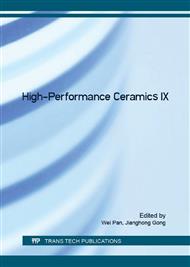[1]
A.V. Talyzin, S.M. luzan, I.V. Anoshkin, A.G. Nasibulin, H. Jiang and E.I. Kauppinen, Hydrogen-driven collapse of C60 inside single-walled carbon nanotubes, Angew. Chem. Int. Ed. 51 (2012) 4435-4439.
DOI: 10.1002/anie.201200946
Google Scholar
[2]
P. Utko, R. Ferone, I.V. Krive, R.I. Shekhter, M. Jonson, M. Monthioux, L. Noe and J. Nygard, Nanoelectromechanical coupling in fullerene peapods probed by resonant electrical transport experiments, Nat. Commun. 1 (2010) 37.
DOI: 10.1038/ncomms1034
Google Scholar
[3]
B.W. Smith, M. Monthioux and D.E. Luzzi, Encapsulated C60 in carbon nanotubes, Nature 396(6709) (1998) 323-324.
DOI: 10.1038/24521
Google Scholar
[4]
B.W. Smith, M. Monthioux and D.E. Luzzi, Carbon nanotube encapsulated fullerenes: a unique class of hybrid materials, Chem. Phys. Lett. 315 (1999) 31-36.
DOI: 10.1016/s0009-2614(99)00896-9
Google Scholar
[5]
Bandow, M. Takizawa, K. Hirahara, M. Yudasaka and S. Iijima, Raman scattering study of double-wall carbon nanotubes derived from the chains of fullerenes in single-wall carbon nanotubes, Chem. Phys. Lett. 337 (2001) 48-54.
DOI: 10.1016/s0009-2614(01)00192-0
Google Scholar
[6]
M. Soto, T.A. Boyer, S. Biradar, L. Ge, R. Vajtai, A. Elias-Zuniga, P.M. Ajayan and E.V. Barrera, Effect of interwall interaction on the electronic structure of double-walled carbon nanotubes, Nanotechnology 26 (2015) 165201.
DOI: 10.1088/0957-4484/26/16/165201
Google Scholar
[7]
K.E. Moore, D.D. Tune and B.S. Flavel, Double-walled carbon nanotube processing, Adv. Mater. 27 (2015) 3105-3137.
DOI: 10.1002/adma.201405686
Google Scholar
[8]
T. Okazaki, S. Bandow, G. Tamura, Y. Fujita, K. Lakoubovskii, S. Kazaoui, N. Minami, T. Saito, K. Suenaga and S. Lijima, Photoluminescence quenching in peapod-derived double-walled carbon nanotubes, Phys. Rev. B. 74(15) (2006) 153404.
DOI: 10.1103/physrevb.74.153404
Google Scholar
[9]
C. Bousige, S. Rols, E. Paineau, S. Rouziere, C. Mocuta, H. Kataura and P. Launois, In situ X-ray diffraction observation of two-step fullerene coalescence in carbon peapods, Eur. Phys. Lett. 103 (2013) 66002.
DOI: 10.1209/0295-5075/103/66002
Google Scholar
[10]
J.Y. Zhang, F. Zhou, Y. Miyata, H. Su and H. Shinohara, Chirally selective growth and extraction of single-wall carbon nanotubes via fullerene nano-peapods, RSC Adv. 3(38) (2013) 16954-16957.
DOI: 10.1039/c3ra43133a
Google Scholar
[11]
S. Han, M. Yoon, S. Berber, N. Park, E. Osawa, J. Ihm and D. Tomanek, Microscopic mechanism of fullerene fusion, Phys. Rev. B. 70(11) (2004) 113402.
DOI: 10.1103/physrevb.70.113402
Google Scholar
[12]
I. lee, S. Jun, H. kim, S.Y. Kim and Y. Lee, Adatom-assisted structural transformations of fullerenes, Appl. Phys. Lett. 88 (2006) 011913.
DOI: 10.1063/1.2161175
Google Scholar
[13]
F. Ding, Z.W. Xu, B.I. Yakobson, R.J. Young, L.A. Kinloch, S. Cui, L.B. Deng, P. Puech and M. Monthioux, Formation mechanism of peapod-derived double-walled carbon nanotubes, Phys. Rev. B. 82(4) (2010) 041403.
DOI: 10.1103/physrevb.82.041403
Google Scholar
[14]
Z.W. Xu, H. Li, K. Fujisawa, Y.A. Kim, M. Endo and F. Ding, Multiple intra-tube junctions in the inner tube of peapod-derived double walled carbon nanotubes: theoretical study and experimental evidence, Nanoscale 4(1) (2012) 130-136.
DOI: 10.1039/c1nr10889a
Google Scholar
[15]
J. Han, M.P. Anantram, R.L. Jaffe, J. Kong and H. Dai, Observation and modeling of single-wall carbon nanotube bend junctions, Phys. Rev. B. 57(23) (1998) 14983-14989.
DOI: 10.1103/physrevb.57.14983
Google Scholar
[16]
Z. Yao, H.W.C. Postma, L. Balents and C. Dekker, Carbon nanotube intramolecular junctions, Nature 402(6759) (1999) 273-276.
DOI: 10.1038/46241
Google Scholar
[17]
M. Ouyang, J.L. Huang, C.L. Cheung and C.M. Lieber, Atomically resolved single-walled carbon nanotube intramolecular junctions, Science 291(5) (2001) 97-100.
DOI: 10.1126/science.291.5501.97
Google Scholar
[18]
D.W. Brenner, O.A. Shenderova, J.A. Harrison, S.J. Stuart, B. Ni and S. Sinnott, A second-generation reactive empirical bond order (REBO) potential energy expression for hydrocarbons, J. Phys. : Condens. Matter 14 (2002) 783-802.
DOI: 10.1088/0953-8984/14/4/312
Google Scholar
[19]
F. Ding and B.I. Yakobson, Energy-driven kinetic Monte Carlo method and its application in fullerene coalescence, J. Phys. Chem. Lett. 5 (2014) 2922-2926.
DOI: 10.1021/jz501324y
Google Scholar
[20]
A.J. Stone and D.J. Wales, Theoretical studies of icosahedral C60 and some related species, Chem. Phys. Lett. 128(5-6) (1986) 501-503.
DOI: 10.1016/0009-2614(86)80661-3
Google Scholar
[21]
H. Chadli, F. Fergani, M. Bentaleb, B. Fakrach, K. Sbai, A. Rahmani, J.L. Bantignies and J.L. Sauvajol, Influence of packing on the vibrations of homogeneous bundles of C60 peapods, Physica E 71 (2015) 31-38.
DOI: 10.1016/j.physe.2015.03.018
Google Scholar


